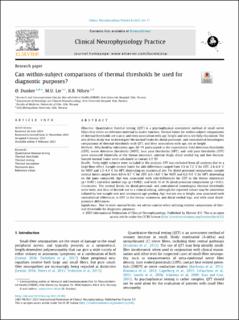| dc.contributor.author | Dunker, Øystein | |
| dc.contributor.author | Lie, Marie | |
| dc.contributor.author | Nilsen, Kristian Bernhard | |
| dc.date.accessioned | 2022-01-20T15:52:45Z | |
| dc.date.available | 2022-01-20T15:52:45Z | |
| dc.date.created | 2021-06-02T14:12:26Z | |
| dc.date.issued | 2021-02-04 | |
| dc.identifier.citation | Clinical Neurophysiology Practice. 2021, 6 63-71. | en_US |
| dc.identifier.issn | 2467-981X | |
| dc.identifier.uri | https://hdl.handle.net/11250/2838554 | |
| dc.description.abstract | Objective: Quantitative thermal testing (QTT) is a psychophysical assessment method of small nerve fibers that relies on reference material to assess function. Normal limits for within-subject comparisons of thermal thresholds are scarce, and their association with age, height and sex is not fully elucidated. The aim of this study was to investigate the normal limits for distal-proximal– and contralateral homologous comparisons of thermal thresholds with QTT, and their association with age, sex or height.
Methods: Fifty healthy volunteers ages 20–79 participated in the experiment. Cold detection thresholds (CDT), warm detection thresholds (WDT), heat pain thresholds (HPT), and cold pain thresholds (CPT) were measured bilaterally at the thenar eminence, anterior thigh, distal medial leg and foot dorsum. Sample normal limits were calculated as (mean) ± 2 SD.
Results: Forty-eight subjects were included in the analysis. CPT was excluded from all analyses due to a large floor-effect. Sample normal limits for side-differences ranged from 1.8 to 7.2 °C for CDT, 2.4–6.8 °C for WDT and 3.2–4.0 °C for HPT, depending on anatomical site. For distal-proximal comparisons, sample normal limits ranged from 4.0 to 8.7 °C for CDT, 6.0–14.0 °C for WDT and 4.2–9.0 °C for HPT, depending on the pairs compared. Age was associated with side-differences for CDT in the thenar eminences (p < 0.001) and distal medial legs (p < 0.002), and with 11 of 18 distal-proximal comparisons (p < 0.01).
Conclusions: The normal limits for distal-proximal- and contralateral homologous thermal thresholds were wide, and thus of limited use in a clinical setting, although the reported values may be somewhat inflated by low sample-size and consequent age-pooling. Age, but not sex or height, was associated with contralateral differences in CDT in the thenar eminences and distal medial legs, and with most distal-proximal differences.
Significance: Due to wide normal limits, we advise caution when utilizing relative comparisons of thermal thresholds for diagnostic purposes. | en_US |
| dc.description.sponsorship | Funding was received from Oslo University Hospital and Oslo Metropolitan University. | en_US |
| dc.language.iso | eng | en_US |
| dc.publisher | Elsevier | en_US |
| dc.relation.ispartofseries | Clinical Neurophysiology Practice;Volume 6 | |
| dc.rights | Navngivelse 4.0 Internasjonal | * |
| dc.rights.uri | http://creativecommons.org/licenses/by/4.0/deed.no | * |
| dc.subject | Quantitative thermal testing | en_US |
| dc.subject | Thermal thresholds | en_US |
| dc.subject | Thermal testing | en_US |
| dc.subject | Thermal perceptions | en_US |
| dc.subject | Normative data | en_US |
| dc.subject | Reference values | en_US |
| dc.title | Can within-subject comparisons of thermal thresholds be used for diagnostic purposes? | en_US |
| dc.type | Peer reviewed | en_US |
| dc.type | Journal article | en_US |
| dc.description.version | publishedVersion | en_US |
| dc.rights.holder | © 2021 International Federation of Clinical Neurophysiology. | en_US |
| cristin.ispublished | true | |
| cristin.fulltext | original | |
| cristin.qualitycode | 1 | |
| dc.identifier.doi | https://doi.org/10.1016/j.cnp.2021.01.002 | |
| dc.identifier.cristin | 1913305 | |
| dc.source.journal | Clinical Neurophysiology Practice | en_US |
| dc.source.volume | 6 | en_US |
| dc.source.pagenumber | 63-71 | en_US |

